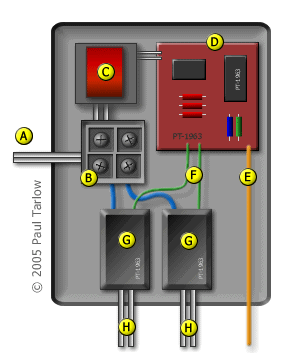A kiln controller automatically manages the heat levels within a kiln so that specific firing schedules can be run unattended.
How a kiln controller works:*
Power is brought into the controller ("A" in the diagram below) from the outside service. It is split at a terminal block ("B") with electricity going to a transformer ("C") and to power relays ("G").
The purpose of the transformer ("C") is to reduce the power to a suitable level for the circuit board controller ("D"). This controller has the ability to read the temperature from a wire ("E") that connects the to the thermocouple inside the kiln (not shown).
As the controller ("D") reads the temperature, it sends a relatively small amount of electricity through wires ("F") to the relays ("G"). Relays are automated power switches – when the controller sends an electrical current, the relay turns on the power to the kiln coils (through wires "H").
Through this process of reading the temperature and cycling the relays on and off, the kiln controller is able to maintain the desired temperatures.

*It is very important to note that this diagram and text are intended to illustrate principles only. Do not try and connect, modify or repair your controller using this picture as a reference. There is sufficient electricity in a kiln controller to kill you. Never open the controller housing or otherwise attempt to modify or repair a controller unless 1) you are a qualified professional and 2) you have fully disconnected the power. If the first thing is true then I shouldn't even need to tell you the second thing.
![]()
![]()

